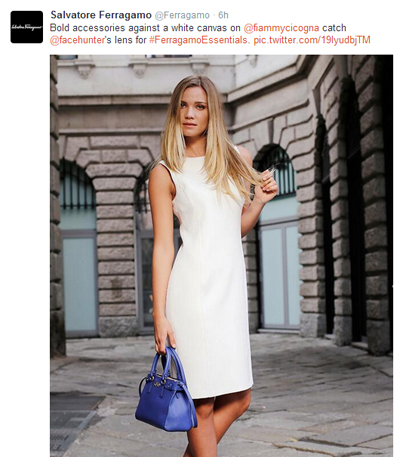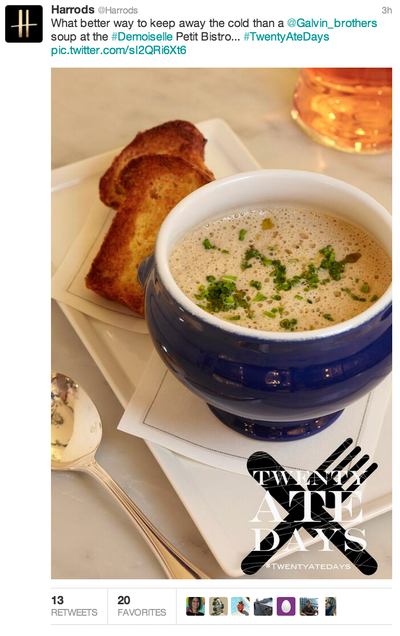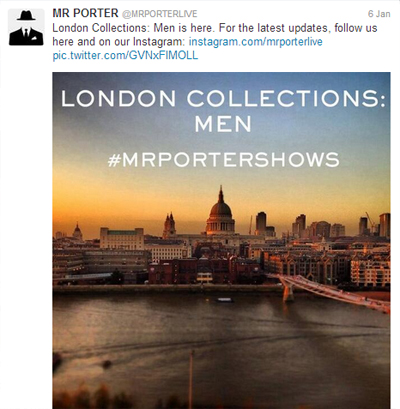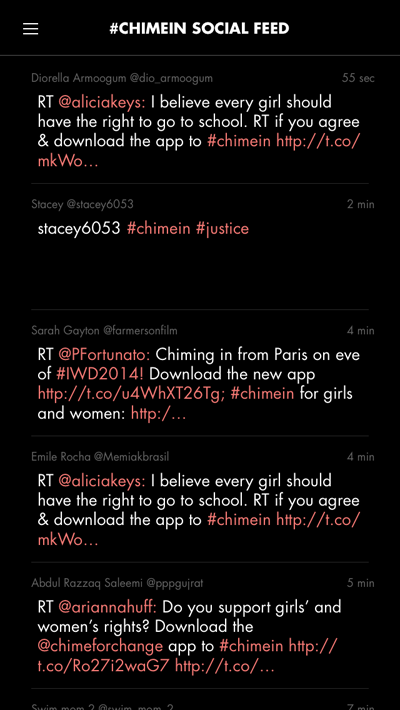Fashion brands, retailers look to Twitter for liberated communication
Luxury brands have become increasingly conversational on Twitter, allowing access to designers via Q&A sessions or retweeting what their consumers are saying.
Twitter offers brands the opportunity to speak directly to consumers and amplify what they are saying about the brand through retweets and replies. The most successful brands are the ones that use this platform as a two-way communication tool.
“Luxury brands on Twitter should be actively communicating with their audience, since the platform allows for one-to-one dialogue at scale but most importantly, the ability to listen,” said Brian Honigman, New York-based content marketing consultant and social media marketer.
“Listen to what your audience is saying to help inform future campaigns, product offerings and how your business is perceived to best meet the needs of your customer base,” he said. “Lastly, sharing behind-the- scenes content on Twitter does well for luxury brands because consumers are so interested in feeling a part of the lifestyle.
“Twitter helps a luxury brand become personable by allowing their customer base who may not have access to the same events, people and circumstances to see updates from these activities in real-time. This helps enforce the exclusivity since customers are able to see that the exclusivity around the brand lifestyle still exists, but they are able to experience glimpses of it.”
Line of communication
Twitter works well for a series of posts, since brands can create very specific hashtags for a group of tweets so they are easily searchable.
For instance, Ferragamo ran a week-long series of images shot by bloggers on its Twitter and Instagram exclusively using the branded hashtag #FerragamoEssentials. Since it worked with well-established bloggers, the brand benefited from the additional audience it received from the bloggers’ own tweets about the project (see story).
Harrods also used the microblogging platform for a series, showing off its restaurants in a #TwentyAteDays series of daily posts throughout the month of February (see story).
Giving consumers exclusive access is one way to create loyalty through social media.
For instance, Italian fashion house Fendi hosted a Twitter conversation between accessories creative director Silvia Venturini Fendi and fashion blogger Susanna Lau of Style Bubble.
Fendi asked fans to submit questions prior to the talk by tweeting with the branded hashtag #Fenditalks, which were then posed to Ms. Fendi by Ms. Lau. By hosting this Fendi talk, the brand was able to boost consumer engagement with its relatively new Twitter account, and possibly gained some followers from Ms. Lau’s fans (see story).
Online retailer Net-A-Porter hosts a beauty chat frequently on its Twitter. Users can tweet questions tagged #NetABeauty to a beauty expert, and they will be answered through Net-A-Porter’s account.
British retailers became media themselves this London Fashion Week by creating their own content around the menswear shows to demonstrate their involvement in the events.
Both Harrods and Mr Porter updated their social media accounts, as well as their Web sites, with photos and videos of the fashion shows they attended, giving their followers backstage accounts of the productions. The majority of the content from both retailers was posted to Twitter, as they live-tweeted runway shows and shared their thoughts on the collections (see story).
Barneys New York also made its presence known during New York Fashion Week with a branded hashtag, #BNYFW. Barneys’ #BNYFW hashtag varies from the other established Mercedes-Benz Fashion Week hashtags such as #NYFW and #MBFW (see story).
Twitter can go beyond commerce for brands.
For instance, Gucci geared up its awareness initiatives for International Women’s Day on March 8 by releasing an iOS application for its Chime for Change organization.
The app allows users to easily share a tweet about the organization’s missions just by shaking their device. By prompting social media sharing through this app, Gucci will likely see more of a conversation develop around Chime for Change than they would by soliciting organic social media posts (see story).
Personal touch
A number of brands have a singular spokesperson behind their Twitter account, allowing for a more conversational, personal feed.
Aliza Licht, senior vice president of global communications for Donna Karan, tweets as DKNY PR girl under the account @DKNY. Similarly, Oscar de la Renta’s senior vice president of communications, Erika Bearman, tweets from the handle @OscarPRgirl.
In addition to tweeting about their respective brands, these women share tidbits from their own lives, such as Ms. Licht’s live-tweeting during TV drama “Scandal” each week.
Bergdorf Goodman also has a singular face behind its Twitter, Cannon Hodge, the retailer’s social media manager, who engages with consumers, retweeting what consumers are posting about the store and adding her own commentary. Ms. Hodge has said that listening to consumers allows the store to provide better service and connect with them on a human level (see story).
While most fashion brands have become very conversational on the platform, some preserve the medium as more of a broadcast channel than an open dialogue.
Chanel, Tom Ford and Prada have followers, but do not follow any accounts outside their own company. This is reflected in how they use the platform, with minimal tweets at other users and the majority of posts coming from the brand rather than being a mixture of retweets and original content.
Reaching out
Brands often use promoted tweets to reach a larger audience when launching a new campaign or social video.
For instance, Donna Karan New York’s #DKNYARTWORKS campaign depended on promoted tweets that generated engagement levels higher than 3 percent and garnered 11.2 million impressions over a three-week span.
The hashtag trended globally twice and resulted in a cost per engagement of 17 cents. Through this campaign, the brand was able to familiarize fans with its art-entwined origins, drive substantial online traffic and bring several luminaries to a prominent stage (see story).
Twitter is increasing the likelihood that brands will actually reach core consumers with promoted tweets through the new Tailored Audience capability.
The new function allows brands to craft tweets that reach ultra-specific consumers such as those who just visited a branded Web site. With this heightened ability to reach key audiences, Twitter may be pulling ahead of other social media platforms as the go-to marketing destination (see story).
On top of text, it is important for brands to include media, which helps make their content stand out in consumers’ Twitter feeds.
“Use media-rich content like photos and videos in your tweets to best highlight your products and their use to your customers,” Mr. Honigman said. “Twitter cards are a newer form of Twitter advertising that luxury brands can use to better feature their product offerings within a tweet or encourage Twitter users to sign up for their email newsletter.”
Brands that have been wary of joining Twitter should think again, since there are benefits to being on the platform, and they may already be represented by consumers posting about them. Being on the social network allows them to better shape the conversation around their brand.
“The ability to have one-to-one dialogue with your audience and share content with them in real-time at events is one of the biggest benefits of using Twitter as a luxury brand,” Mr. Honigman said.
“A brand should join the social network to tap into a vast resource of consumer insights to ensure they are able to listen and engage in negative and positive conversations happening about their business,” he said.
Final Take
Sarah Jones, editorial assistant on Luxury Daily, New York






